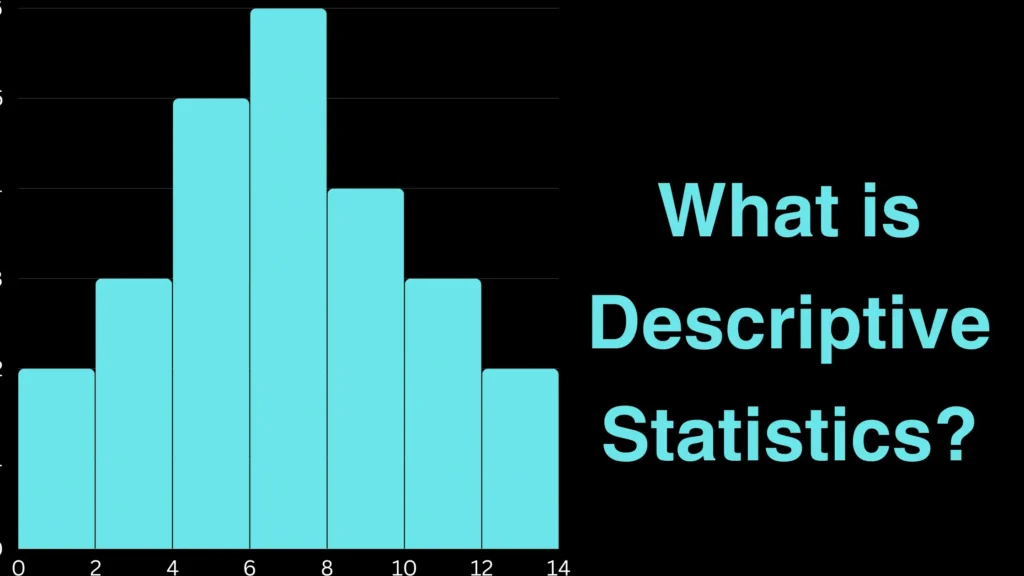Descriptive statistics is a crucial branch of statistics that focuses on summarizing and describing the main features of a dataset. It provides a way to present data in a meaningful and easily understandable manner, using various techniques such as measures of central tendency, measures of dispersion, and graphical representations. In this lecture, we will delve into the world of descriptive statistics, exploring its key concepts, methods, and applications.
Introduction to Descriptive Statistics
Descriptive statistics is an essential tool for understanding and communicating the characteristics of a dataset. It allows us to condense large amounts of data into a few summary measures and visualizations, making it easier to grasp the overall patterns and trends within the data.
The primary goals of descriptive statistics are:
- To provide a clear and concise summary of the data
- To identify patterns, trends, and relationships within the data
- To communicate the main features of the data to others
- To lay the foundation for further statistical analysis
In order to achieve these goals, descriptive statistics employs various measures and techniques, which we will explore in detail throughout this lecture.
Types of Data
Before diving into the specific methods of descriptive statistics, it is essential to understand the different types of data that we may encounter. There are two main types of data: categorical and numerical.
Categorical Data
Categorical data, also known as qualitative data, represents characteristics or attributes that can be divided into distinct categories or groups. Examples of categorical data include:
- Gender (male, female, other)
- Color (red, blue, green, etc.)
- Marital status (single, married, divorced, widowed)
Categorical data can be further classified into two subtypes:
- Nominal data: Categories have no inherent order or ranking (e.g., color, gender)
- Ordinal data: Categories have a natural order or ranking (e.g., education level: high school, bachelor’s, master’s, doctorate)
Numerical Data
Numerical data, also known as quantitative data, represents measurements or quantities that can be expressed as numbers. Numerical data can be further divided into two subtypes:
- Discrete data: Data that can only take on specific values, typically integers (e.g., number of children in a family, number of cars owned)
- Continuous data: Data that can take on any value within a certain range (e.g., height, weight, temperature)
Understanding the type of data you are working with is crucial, as it determines the appropriate descriptive statistics methods to use.
Measures of Central Tendency
Measures of central tendency describe the center or middle point of a dataset. They provide a single value that represents the typical or average value within the data. The three main measures of central tendency are the mean, median, and mode.
Mean
The mean, also known as the arithmetic average, is the most commonly used measure of central tendency. It is calculated by adding up all the values in a dataset and dividing by the number of observations.
Mathematically, the mean of a dataset ${x_1, x_2, …, x_n}$ with $n$ observations is given by:
$\bar{x} = \frac{1}{n} \sum_{i=1}^{n} x_i$
where $\bar{x}$ is the mean, $x_i$ represents each individual value, and $n$ is the total number of observations.
Example: Consider the following dataset of test scores: ${80, 85, 90, 75, 95}$. To calculate the mean, we add up all the values and divide by the number of observations:
$\bar{x} = \frac{80 + 85 + 90 + 75 + 95}{5} = \frac{425}{5} = 85$
The mean test score is 85.
Median
The median is the middle value in a dataset when the values are arranged in ascending or descending order. If there is an even number of observations, the median is the average of the two middle values.
To find the median:
- Arrange the data in ascending or descending order
- If the number of observations is odd, the median is the middle value
- If the number of observations is even, the median is the average of the two middle values
Example: Consider the following dataset of ages: ${25, 30, 35, 40, 45}$. The dataset is already arranged in ascending order, and there are an odd number of observations. The median is the middle value, which is 35.
Now, let’s add another age to the dataset: ${25, 30, 35, 40, 45, 50}$. Since there are now an even number of observations, the median is the average of the two middle values:
$\text{Median} = \frac{35 + 40}{2} = 37.5$
Mode
The mode is the value that appears most frequently in a dataset. A dataset can have one mode (unimodal), two modes (bimodal), or more than two modes (multimodal). If no value appears more than once, the dataset has no mode.
Example: Consider the following dataset of favorite colors: ${\text{blue}, \text{red}, \text{green}, \text{blue}, \text{red}, \text{blue}}$. The mode of this dataset is blue, as it appears most frequently (three times).
Choosing the appropriate measure of central tendency depends on the type of data and the presence of outliers (extreme values that differ greatly from the majority of the data). The mean is sensitive to outliers, while the median and mode are more robust.
Measures of Dispersion
Measures of dispersion describe the spread or variability of a dataset. They provide information about how much the data values deviate from the central tendency measures. The main measures of dispersion are the range, variance, and standard deviation.
Range
The range is the simplest measure of dispersion and is defined as the difference between the largest and smallest values in a dataset.
$\text{Range} = \text{Maximum Value} – \text{Minimum Value}$
Example: Consider the following dataset of ages: ${25, 30, 35, 40, 45}$. The range is:
$\text{Range} = 45 – 25 = 20$
The range provides a quick and easy way to understand the spread of the data, but it is sensitive to outliers and does not provide information about the distribution of values within the dataset.
Variance
The variance measures how far each value in the dataset is from the mean. It is calculated by taking the average of the squared differences from the mean.
The formula for the population variance is:
$\sigma^2 = \frac{\sum_{i=1}^{N} (x_i – \mu)^2}{N}$
where $\sigma^2$ is the population variance, $x_i$ represents each individual value, $\mu$ is the population mean, and $N$ is the total number of observations in the population.
For a sample, the formula is slightly different:
$s^2 = \frac{\sum_{i=1}^{n} (x_i – \bar{x})^2}{n – 1}$
where $s^2$ is the sample variance, $x_i$ represents each individual value, $\bar{x}$ is the sample mean, and $n$ is the total number of observations in the sample.
Example: Consider the following sample of test scores: ${80, 85, 90, 75, 95}$. To calculate the sample variance:
- Calculate the sample mean: $\bar{x} = 85$
- Subtract the mean from each value and square the differences: $(80 – 85)^2 = (-5)^2 = 25$, $(85 – 85)^2 = 0$, $(90 – 85)^2 = 5^2 = 25$, $(75 – 85)^2 = (-10)^2 = 100$, $(95 – 85)^2 = 10^2 = 100$
- Sum the squared differences: $25 + 0 + 25 + 100 + 100 = 250$
- Divide by $(n – 1)$: $s^2 = \frac{250}{4} = 62.5$
The sample variance is 62.5.
Standard Deviation
The standard deviation is the square root of the variance. It provides a measure of the spread of the data in the same units as the original dataset, making it easier to interpret than the variance.
The formula for the population standard deviation is:
$\sigma = \sqrt{\frac{\sum_{i=1}^{N} (x_i – \mu)^2}{N}}$
where $\sigma$ is the population standard deviation, $x_i$ represents each individual value, $\mu$ is the population mean, and $N$ is the total number of observations in the population.
For a sample, the formula is:
$s = \sqrt{\frac{\sum_{i=1}^{n} (x_i – \bar{x})^2}{n – 1}}$
where $s$ is the sample standard deviation, $x_i$ represents each individual value, $\bar{x}$ is the sample mean, and $n$ is the total number of observations in the sample.
Example: Using the sample variance calculated in the previous example ($s^2 = 62.5$), the sample standard deviation is:
$s = \sqrt{62.5} \approx 7.91$
The sample standard deviation is approximately 7.91, meaning that the test scores deviate from the mean by an average of 7.91 points.
Graphical Representations
Graphical representations are visual tools used to display the distribution and characteristics of a dataset. They help to quickly convey information about the data and can reveal patterns, trends, and outliers that may not be apparent from summary statistics alone. Some common graphical representations include histograms, bar charts, and box plots.
Histograms
Histograms display the distribution of a continuous variable by dividing the data into bins (intervals) and showing the frequency or count of observations in each bin. The bins are represented by adjacent rectangles, with the height of each rectangle proportional to the frequency or count of observations within that bin.
To create a histogram:
- Divide the range of the data into equal-sized bins
- Count the number of observations falling into each bin
- Draw adjacent rectangles with heights proportional to the frequency or count in each bin
Example: Consider the following dataset of ages: ${25, 28, 30, 32, 35, 36, 38, 40, 42, 45}$. To create a histogram with bin widths of 5 years:
- Divide the range (25 to 45) into equal-sized bins: 25-29, 30-34, 35-39, 40-44, 45-49
- Count the number of observations in each bin: 2, 1, 3, 2, 2
- Draw the histogram (see Figure 1)
[Insert Figure 1: Histogram of Ages]
Histograms provide a clear visual representation of the distribution of continuous data, allowing for quick identification of patterns, central tendency, and dispersion.
Bar Charts
Bar charts are used to display the distribution of a categorical variable. Each category is represented by a bar, and the height of the bar corresponds to the frequency or count of observations in that category.
To create a bar chart:
- List the categories on the x-axis
- For each category, draw a bar with height proportional to the frequency or count of observations
Example: Consider the following dataset of favorite colors: ${\text{blue}, \text{red}, \text{green}, \text{blue}, \text{red}, \text{blue}, \text{green}, \text{red}}$. To create a bar chart:
- List the categories (colors) on the x-axis: blue, red, green
- Count the frequency of each color: blue (3), red (3), green (2)
- Draw the bar chart (see Figure 2)
[Insert Figure 2: Bar Chart of Favorite Colors]
Bar charts provide a clear visual comparison of the frequencies or counts of different categories within a dataset.
Box Plots
Box plots, also known as box-and-whisker plots, display the distribution of a continuous variable using five summary statistics: minimum, first quartile (Q1), median, third quartile (Q3), and maximum. They provide a compact way to visualize the central tendency, dispersion, and skewness of a dataset.
To create a box plot:
- Calculate the five summary statistics: minimum, Q1, median, Q3, maximum
- Draw a box spanning from Q1 to Q3, with a line inside the box representing the median
- Draw whiskers extending from the box to the minimum and maximum values
Example: Consider the following dataset of test scores: ${80, 85, 90, 75, 95, 88, 92, 83, 78, 98}$. To create a box plot:
- Calculate the summary statistics:
- Minimum: 75
- Q1: 80.25
- Median: 86.5
- Q3: 92.75
- Maximum: 98
- Draw the box plot (see Figure 3)
[Insert Figure 3: Box Plot of Test Scores]
Box plots provide a concise summary of the distribution of a dataset, including information about central tendency, dispersion, and potential outliers (values that fall far from the box).
Measures of Association
In addition to summarizing individual variables, descriptive statistics can also be used to explore relationships between two or more variables. Measures of association quantify the strength and direction of the relationship between variables.
Correlation
Correlation measures the linear relationship between two continuous variables. The most common measure of correlation is the Pearson correlation coefficient, denoted by $r$. The Pearson correlation coefficient ranges from -1 to +1:
- $r = -1$ indicates a perfect negative linear relationship
- $r = 0$ indicates no linear relationship
- $r = +1$ indicates a perfect positive linear relationship
The formula for the Pearson correlation coefficient is:
$r = \frac{\sum_{i=1}^{n} (x_i – \bar{x})(y_i – \bar{y})}{\sqrt{\sum_{i=1}^{n} (x_i – \bar{x})^2} \sqrt{\sum_{i=1}^{n} (y_i – \bar{y})^2}}$
where $x_i$ and $y_i$ are the individual values of the two variables, $\bar{x}$ and $\bar{y}$ are their respective means, and $n$ is the number of observations.
Example: Consider the following dataset of height (in inches) and weight (in pounds) for 5 individuals:
| Height | Weight |
|---|---|
| 65 | 150 |
| 68 | 160 |
| 70 | 180 |
| 72 | 190 |
| 75 | 200 |
To calculate the Pearson correlation coefficient:
- Calculate the means: $\bar{x} = 70$ (height) and $\bar{y} = 176$ (weight)
- Subtract the means from each value and multiply the differences: $(65 – 70)(150 – 176) = -130$ $(68 – 70)(160 – 176) = -32$ $(70 – 70)(180 – 176) = 0$ $(72 – 70)(190 – 176) = 28$ $(75 – 70)(200 – 176) = 120$
- Sum the products: $-130 – 32 + 0 + 28 + 120 = -14$
- Calculate the sum of squared differences for each variable: $\sum_{i=1}^{n} (x_i – \bar{x})^2 = 100$ $\sum_{i=1}^{n} (y_i – \bar{y})^2 = 2,600$
- Calculate the correlation coefficient: $r = \frac{-14}{\sqrt{100} \sqrt{2,600}} \approx -0.14$
The Pearson correlation coefficient between height and weight is approximately -0.14, indicating a weak negative linear relationship.
Contingency Tables
For categorical variables, the association between two variables can be explored using contingency tables (also known as cross-tabulation tables). A contingency table displays the frequency or count of observations for each combination of categories from two variables.
Example: Consider a survey of 100 individuals, asking about their gender and preferred color (blue or red). The results are:
| Blue | Red | Total | |
|---|---|---|---|
| Male | 30 | 20 | 50 |
| Female | 20 | 30 | 50 |
| Total | 50 | 50 | 100 |
The contingency table shows the distribution of color preference by gender, allowing for the exploration of any potential association between the two variables. In this example, there appears to be a slight association between gender and color preference. Males seem to prefer blue (30 out of 50, or 60%) more than females do (20 out of 50, or 40%), while females seem to prefer red (30 out of 50, or 60%) more than males do (20 out of 50, or 40%).
To quantify the strength of the association, various measures can be used, such as the chi-square test of independence or measures of association like Cramer’s V or the phi coefficient.
Limitations and Considerations
While descriptive statistics provide valuable insights into a dataset, it is essential to be aware of their limitations and to consider the context of the data.
- Descriptive statistics summarize the data but do not explain the underlying causes or mechanisms behind the patterns observed.
- Outliers can heavily influence some measures, particularly the mean and range. It is essential to identify and consider the potential impact of outliers when interpreting results.
- Descriptive statistics are based on the available data and may not necessarily generalize to a larger population. Inferential statistics are needed to make generalizations beyond the sample data.
- The choice of descriptive statistics should be appropriate for the type of data and the research question. Using the wrong measure can lead to misleading interpretations.
- Graphical representations can be powerful tools for communicating results but can also be misleading if not designed and interpreted properly.


![Top 8 DSA Project Ideas in 2024 [With Source Code]](https://evuzzo.com/wp-content/uploads/2024/05/DSA-Project-Ideas-in-2024.png)

![Top 15 Software Engineer Projects 2024 [Source Code]](https://evuzzo.com/wp-content/uploads/2024/04/Top-15-Software-Engineer-Projects-2024-Source-Code.webp)


![Java Developer Resume for 2024 [Templates & Samples]](https://evuzzo.com/wp-content/uploads/2024/04/Java-Developer-Resume-for-2024-Templates-Samples.webp)